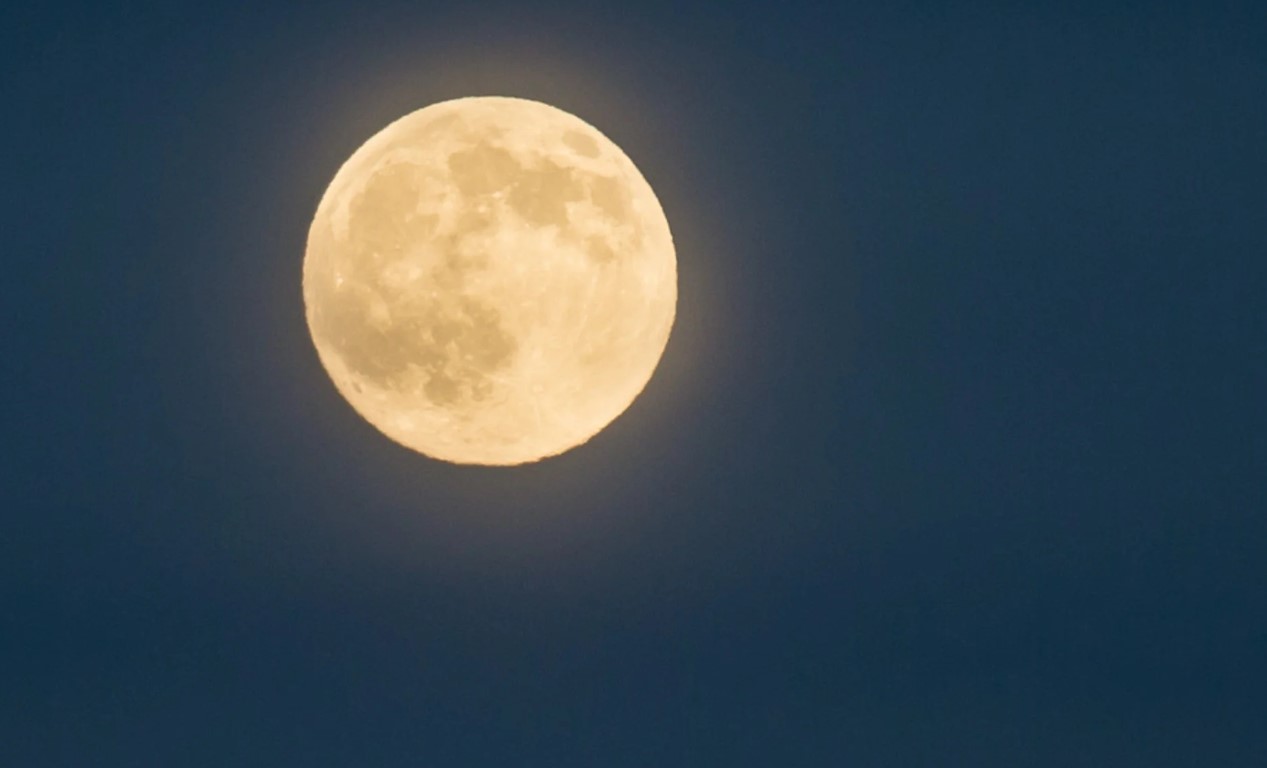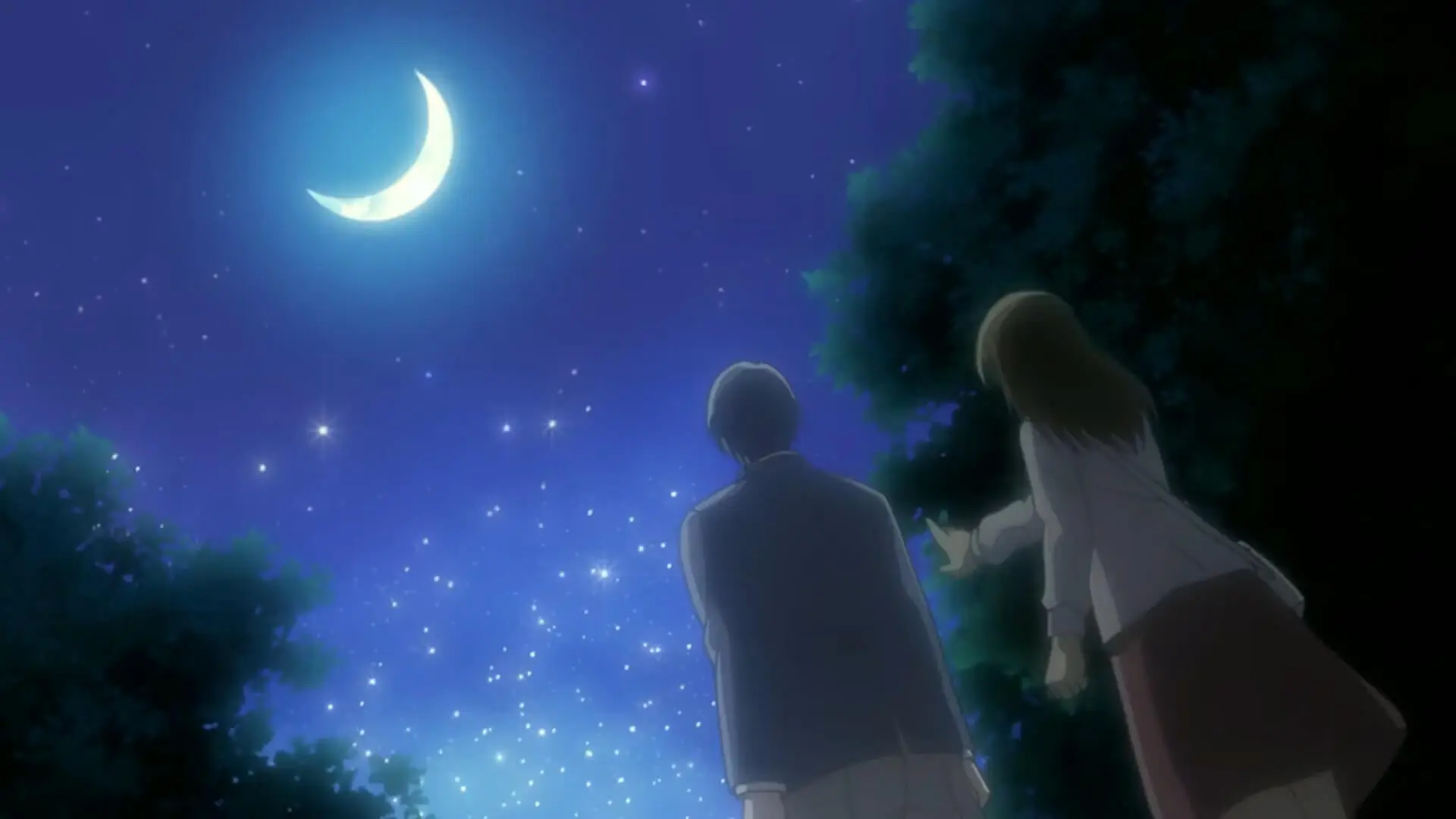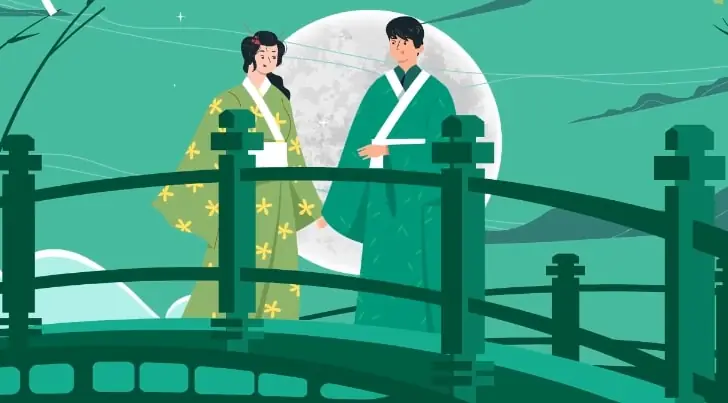
Sometimes, words hit harder when they do not say exactly what they mean. In Japan, saying “The moon is beautiful, isn’t it?” (月が綺麗ですね or Tsuki ga kirei desu ne) goes far beyond admiring the night sky.
This phrase, often credited to Meiji-era writer Natsume Soseki, is a way to say “I love you” without ever saying it.
Legend has it that Soseki suggested this line after hearing a student translate “I love you” too directly, a choice that felt out of tune with Japanese sensibilities. That lead to making a famous Japanese moon confession.
Instead of blunt words, “The moon is beautiful” brings a sense of mystery. For those who know its meaning, it’s like a quiet secret—a way to share something real without spelling it out.
Today, this line has found its place in Japanese culture. In anime, novels, and dramas, characters might say it when a direct confession feels too heavy.
It hints at what they feel, creating a moment where a simple phrase holds all the meaning that matters.
Origins of the Phrase

The phrase “The moon is beautiful, isn’t it?” (Tsuki ga kirei desu ne) has a story connected to the celebrated Japanese writer Natsume Soseki.
During the Meiji era, Soseki reportedly came across a student translating the words “I love you” directly into Japanese, which felt unnatural in a culture where subtlety and indirect language often matter more.
He suggested using “The moon is beautiful, isn’t it?” as a softer, poetic way to convey affection, believing it more fitting to Japanese values.
Who Was Soseki?
Soseki was one of Japan’s literary icons, known for novels like Kokoro that explore the complexity of human relationships.
Pop Culture Appearance
The phrase still appears in Japanese media, from anime to dramas, often marking a quiet moment where a character wants to express love without saying it directly.
Why “The Moon is Beautiful” Means “I Love You” in Japan
In Japan, expressing emotions directly can feel awkward or even out of place. Rather than saying “I love you” outright, Japanese culture often values a quieter, more indirect approach.
The phrase “The moon is beautiful, isn’t it?” (Tsuki ga kirei desu ne) came from this tradition of hinting at feelings instead of saying them directly.
Natsume Soseki suggested this line to keep the sentiment of love subtle but meaningful.
Nature as a Symbol
Japan has a deep respect for nature, and using something like the moon as a stand-in for love brings out a quieter kind of romance.
Discomfort with Directness
Saying “I love you” can feel too forceful in Japanese. Instead, phrases like “The moon is beautiful” let people express affection without making it too intense.
Still Relevant in Media
The phrase shows up in anime, dramas, and literature during romantic moments. Younger generations may not say it as much in daily life, but the phrase has become part of Japanese culture.
Natsume Soseki Influence
Natsume Soseki, one of Japan’s most respected writers, introduced the phrase “The moon is beautiful, isn’t it?” as a softer way to say “I love you.” He believed this approach fit Japanese culture better than a direct confession.
Instead of simply stating “I love you,” this phrase uses the moon as a way to express affection quietly, respecting Japan’s more reserved approach to language.
Soseki’s works, like Kokoro, often explored complex emotions and the struggles of connecting with others. This line about the moon wasn’t just a suggestion but part of his larger view on expressing feelings. He felt that using indirect expressions could make emotions feel real without forcing them into words.
Why Soseki’s Influence Stuck Around
- A Language Shift: Soseki’s ideas made indirect expressions of love more accepted, giving people a way to express feelings in a way that matched their comfort level.
- More than Just Words: For Soseki, language was about connecting without overwhelming. This idea has lasted, with his phrase still appearing in Japanese media whenever a character needs to express love quietly.
How It Show Up in Pop Culture?
The phrase “The moon is beautiful, isn’t it?” appears in several anime and manga as a subtle confession of love. Here’s a look at where it’s commonly used:
Tsuki ga Kirei (2017)
Translating to “The Moon is Beautiful,” this anime follows the relationship between two junior high students. They share meaningful moments under the moon, where the phrase lets them express love without needing to say it directly.
Demon Slayer
Used during scenes with characters who struggle to reveal their feelings, Demon Slayer includes this phrase in a moonlit setting, showing how it adds depth to their unspoken emotions.
Also, if you are a fan of Demon Slayer, check out what are the mythical female demon names.
Various Manga
In manga like Kimi ni Todoke, the phrase lets characters share quiet admiration. They often say it when a direct confession might feel too intense, highlighting Japanese storytelling’s love for subtle expressions of romance.
Responses to “The Moon is Beautiful, Isn’t It?”

In Japanese, replying to “The moon is beautiful, isn’t it?” carries just as much weight as the phrase itself.
Each response adds to the moment without spelling out feelings too openly, keeping with the subtle communication style in Japanese culture.
Common Replies and What They Mean
1. “Yes, it really is.” (そうですね / Sou desu ne)
A simple, quiet agreement. It doesn’t say much on the surface, but it’s often used to hint at shared feelings without being too obvious.
2. “I can die happy.” (死んでもいいわ / Shin demo ii was)
Known as a poetic response, this means the listener is so content they need nothing more. The phrase comes from Meiji-era literature, where it captures deep admiration in a single line.
3. “You’re as beautiful as it is.” (あなたも美しい / Anata mo utsukushii)
Taking a step closer to direct affection, this reply softly returns the sentiment, making it clear the listener feels the same without needing to spell it out.
FAQs
How should I respond if someone says “The moon is beautiful, isn’t it?” and I don’t feel the same way?
If someone uses this phrase and you don’t share the sentiment, a respectful reply could be “Yes, it’s nice.” Keeping the response neutral allows you to acknowledge their statement without signaling romantic interest.
Can this phrase be used between friends or only in romantic contexts?
Yes, while typically romantic, “The moon is beautiful, isn’t it?” can also be a way for friends to share a moment of appreciation for the beauty of nature. Context matters—if used casually, it may just be about enjoying the scenery together.
Is the phrase commonly understood by all Japanese people today?
While many are familiar with its romantic meaning, especially through literature and media, younger generations may not immediately recognize it as a declaration of love. In casual or modern settings, the literal meaning might be the only interpretation.
What makes “The moon is beautiful, isn’t it?” different from more direct confessions in Japanese culture?
The phrase offers a subtle, poetic option, in contrast to “Suki desu” or “Aishiteru” (both meaning “I love you”). These direct expressions might feel intense, while referencing the moon allows for an unspoken connection that fits traditional values around the restraint.
Final Words
The phrase “The moon is beautiful, isn’t it?” captures the Japanese approach to expressing emotions indirectly, something that continues to intrigue people worldwide.
With roots in Natsume Soseki’s view of love as something best shared softly, this line has gone from literature to everyday language and pop culture, still holding a poetic charm.
Rather than a simple compliment, the phrase invites someone into a moment that only they share. Its presence in anime, literature, and conversations shows that sometimes, the most subtle words can hold the deepest meaning.

















